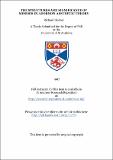The structures and significance of mimesis in Adorno's "Aesthetic Theory"
View/
Date
07/1997Author
Supervisor
Funder
Metadata
Show full item recordAltmetrics Handle Statistics
Abstract
This thesis starts from the point of departure of asking why Aesthetic Theory is difficult to read. In answering this question it is argued that the difficulty of the work is a function of the unusual claims Adorno makes about the relation between art and philosophy, and that the presentation of these arguments exemplifies these claims. This complimentary relation between form and content has implications for the way Adorno can be understood as engaging the idea of mimesis. Aesthetic Theory should be understood as a theory of mimesis in modern art and as a mimetic work itself. Given this idea, the question of the readability of the work emerges as inseparable from the explicit claims Adorno makes for mimesis. If the work ultimately cannot be understood because Adorno does not define his concepts, or it is unexplainable for any other reason, then mimesis will be shown to be untenable. The issue of the readability of Aesthetic Theory is explored in the Introduction through a discussion of issues arising from the recent history of Adorno's reception. Particular attention is paid to the differences between critics who have emphasised the significance of the particular claims Adorno makes against those who emphasise his method. Chapter I rejects this distinction while it argues that the character of Adorno's writing is uneven, that is to say, Aesthetic Theory cannot usefully be read in a uniform way.
Chapter I considers different aspects of this lack of uniformity and argues that the identity of Aesthetic Theory as 'philosophy' is often tenuous as it moves in and out of other modes of argument. Chapters 2 and 3 look at different aspects of the identity of Aesthetic Theory as philosophy. Chapter 2 explains the strategic significance of the work as a continuation of a tradition of philosophy from Hegel onwards. This tradition, it is argued, has explicitly understood the problem of philosophy as recognising itself as experience while it attempts to describe experience. Chapter 3 extends this theme into a consideration of philosophical form. If philosophy is understood as a mode of experience then its form as well as its content is significant. Through a consideration of Heidegger and Derrida, Chapter 3 examines the uniqueness of the philosophical form of Aesthetic Theory. Having made this distinction. Chapter 4 reads Aesthetic Theory as philosophical form, describing aspects of it as mimetic. Chapters 5 and 6 then give detailed readings of parts of Aesthetic Theory which are particularly relevant for an understanding of Adorno's theory of the mimetic potential of modern art. The concluding chapter argues that the internal consistency of Aesthetic Theory in its practice and definition of the crisis of mimesis in modernism has significant implications for the practice of art history and criticism of twentieth-century art.
Type
Thesis
Collections
Items in the St Andrews Research Repository are protected by copyright, with all rights reserved, unless otherwise indicated.

